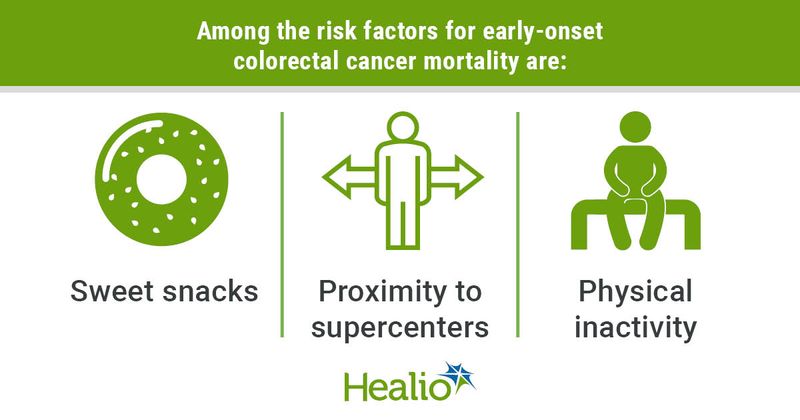Early onset CRC mortality in Southern US linked to poor food environment
Click Here to Manage Email Alerts
Key takeaways:
- Proximity to supercenters and physical inactivity were among risk factors for early-onset CRC mortality.
- Consumption of fruits and vegetables, female gender and high socioeconomic status were protective.
VANCOUVER, British Columbia — The “disproportionate density” of early-onset colorectal cancer mortality in the Southern United States is associated with high food insecurity and low access to healthy food, according to a presenter here.
“Since the 1980s, there has been an increase in the incidence of early-onset colorectal cancer for those younger than age 50,” William K. Oelsner, MD, from the University of Tennessee Health Science Center, said at the ACG Annual Scientific Meeting. “This incidence is set to double by 2030. While the exact mechanism for this rise is still unknown, there have been several proposed factors including obesity, diet, physical inactivity and environmental exposures.”

He continued, “We wanted to create a comprehensive analysis of how food affects early-onset colorectal cancer mortality and to look at regional differences. Specifically, we wanted to know: What are communities eating? Where are they buying food and how does the lack of access to food affect early-onset colorectal cancer mortality?”
To answer these questions, Oelsner and colleagues collected data from the CDC National Programs of Cancer Registries and the Surveillance, Epidemiology and End Results Program and identified 68,495 individuals, aged 20 to 49 years from 1,307 U.S. counties, who died from CRC between 1999 and 2020.
Researchers examined dietary patterns using the Nielsen Homescan National Consumer Panel and assessed county-level food store densities via the USDA Food Environment Atlas. They also studied demographics, including race, gender and socioeconomic status, and known CRC risk factors such obesity, diet, physical inactivity and tobacco abuse.
According to Oelsner, when considering mortality alone, they observed a “disproportionate density” of early-onset CRC mortality in the Southern U.S.
After conducting Pearson correlations, researchers reported an inverse correlation between a healthy food environment (r = –0.46; P < .0001), consumption of fruits and vegetables (r = –0.25; P < .0001) and early onset CRC, whereas consumption of soda (r = 0.37; P < .0001) and meat (r = 0.07; P = .0096) directly correlated with mortality.
“In essence, counties with high early-onset colorectal cancer mortality had an unhealthy food environment, ate fewer fruits and vegetables, and consumed more meat and soda,” Oelsner said.
Using a multivariate linear regression model, researchers found that soda and meat consumption were risk factors for early-onset CRC mortality, while fruit and vegetable consumption was protective.
“Interestingly, when we adjust for demographics and known color colorectal cancer risk factors, candy consumption emerged as a risk factor while fruit and vegetable consumption continued to be protective,” Oelsner said.
Additionally, when examining specific food sources, specialty food stores were considered protective, while grocery stores and gas stations were risk factors. After adjusting for demographics and known CRC risk factors, Oelsner noted that proximity to supercenters or warehouse clubs was a risk factor for morality, “suggesting that counties with higher density of bulk-packaging food stores had increased early-onset colorectal cancer mortality.”
In a final composite model, researchers reported that fruit and vegetable consumption, female gender and high socioeconomic status were protective, while consumption of sweet snacks, supercenter store density and rural counties were identified as risk factors for early-onset CRC mortality, as were African American race and physical inactivity.
According to Oelsner, geographic analysis yielded two distinct populations: The Southeast and Southwest regions of the U.S. had a strong association between early-onset CRC mortality and an unhealthy food environment, while the East/Northcentral states and Southern California did not have an association with food environment. These results suggest that early-onset CRC mortality is associated with high food insecurity and low access to healthy food.
“As a whole, this research is suggestive that dietary counseling should include increased fruit and vegetable consumption and decreased sweet snack and candy intake to reduce early-onset colorectal cancer mortality,” Oelsner concluded. “Population-based public health initiatives aimed at improving the food environment may lower early-onset colorectal cancer mortality, particularly in the Southern U.S.”

